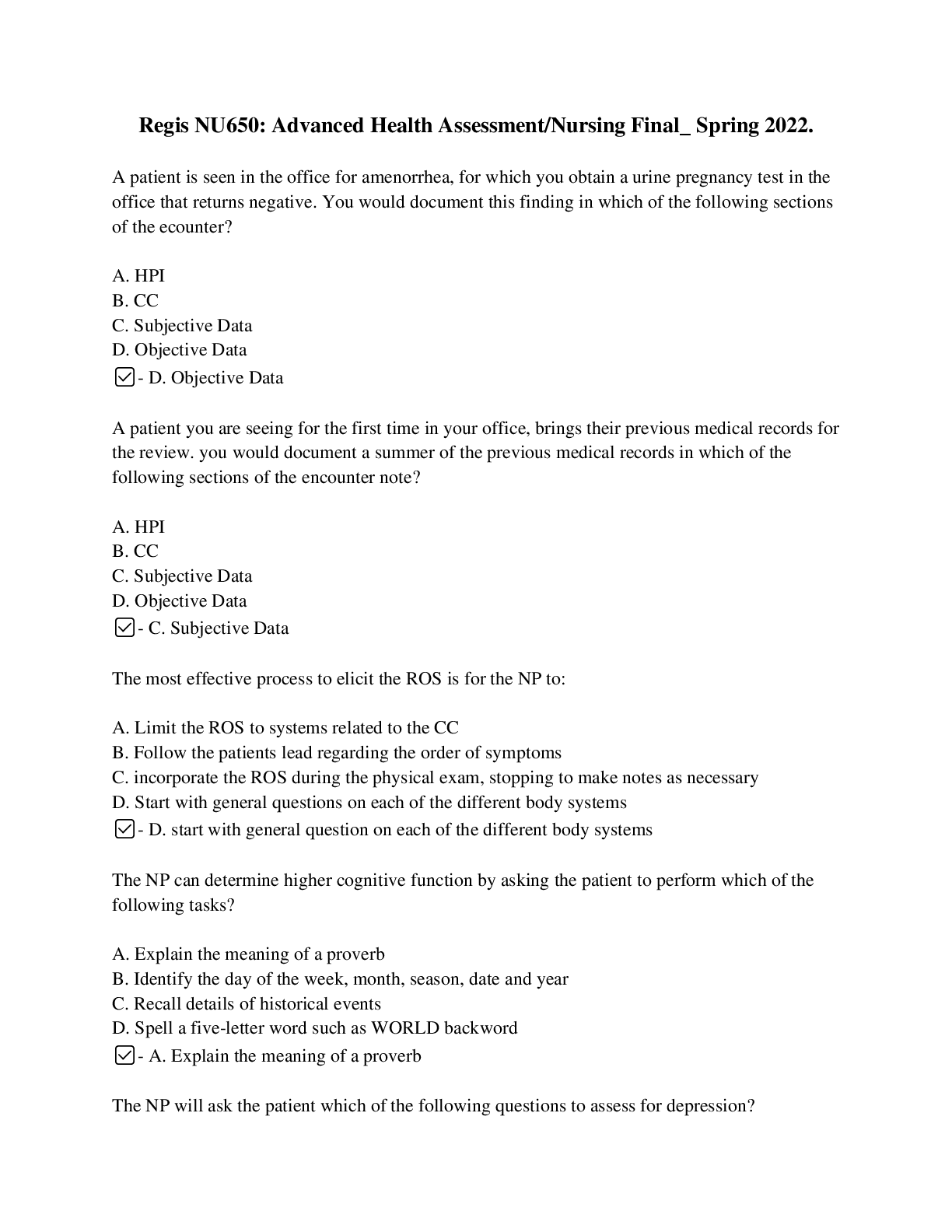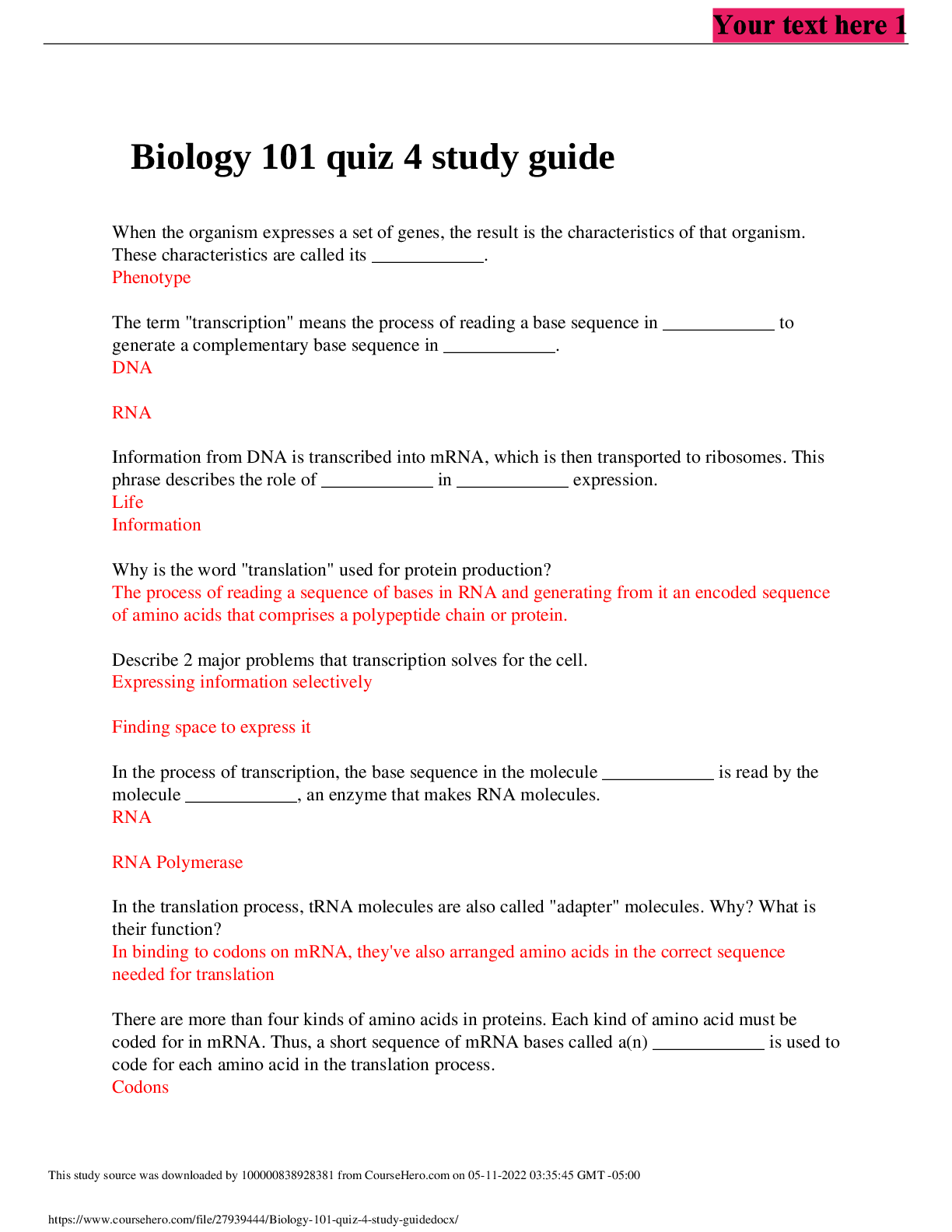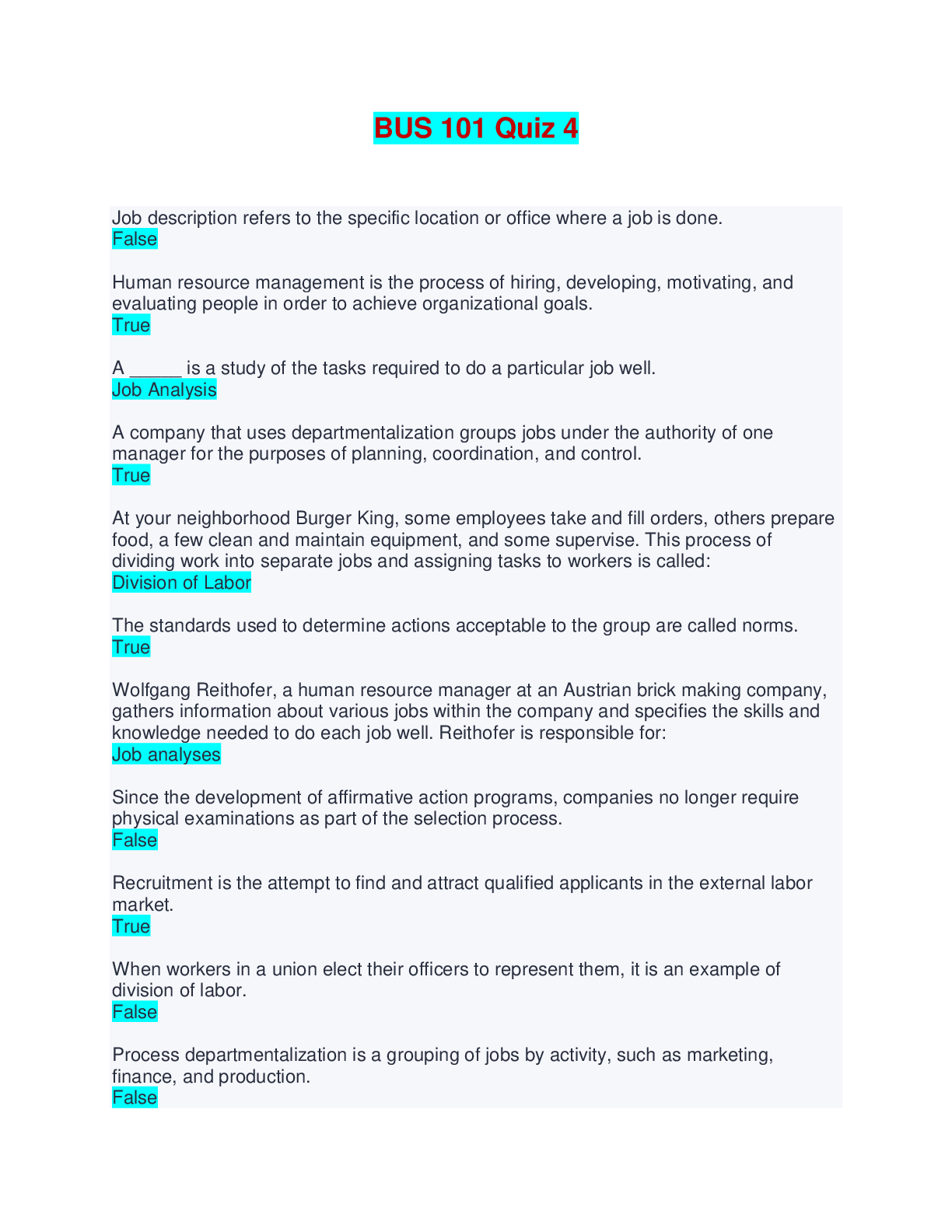University of Maryland - BIOL 101 Quiz 4 with answers. Already Graded A.
Document Content and Description Below
BIOL 101 Quiz 4 Latest 2019/20 Question 1 (5 points) A karyotype ______. Question 1 options: is a visual display of chromosomes arranged according to size. compares one set of chromoso... mes to another. is a photograph of cells undergoing mitosis during anaphase. cannot be used to identify individual chromosomes beyond the fact that two chromosomes are homologues. of a normal human cell shows 48 chromosomes. Save Question 2 (5 points) All of the following are characteristics of cancer cells EXCEPT _____. Question 2 options: unregulated mitosis no apoptosis angiogenesis unmutated DNA ability to metastasize Save Question 3 (5 points) A cell is arrested during mitosis. At this stage, distinct chromatids are visible at opposite poles of the cell. Which stage of mitosis does this describe? Question 3 options: Metaphase Telophase Prophase Interphase Anaphase Question 4 (5 points) If the cell whose nuclear material is shown in the figure continues toward completion of mitosis, which of the following events would occur next? Question 4 options: formation of telophase nuclei spindle fiber formation cell membrane synthesis synthesis of chromatids nuclear envelope breakdown Save Question 5 (5 points) What stage does cytokinesis generally overlap with in the typical cell cycle? Question 5 options: S phase prophase telophase anaphase metaphase Save Question 6 (5 points) After telophase I of meiosis, the chromosomal makeup of each daughter cell is ____. Question 6 options: haploid, and the chromosomes are each composed of a single chromatid. diploid, and the chromosomes are each composed of two chromatids. haploid, and the chromosomes are each composed of two chromatids. diploid, and the chromosomes are each composed of a single chromatid. tetraploid, and the chromosomes are each composed of two chromatids. Question 7 (5 points) If a cell has completed the first meiotic division and is just beginning meiosis II, which of the following is an appropriate description of its contents? Question 7 options: It has half the amount of DNA as the cell that began meiosis. It has the same number of chromosomes but each of them has different alleles than another cell from the same meiosis. It is identical in content to another cell from the same meiosis. It has half the chromosomes but twice the DNA of the originating cell. It has one-fourth the DNA and one-half the chromosomes as the originating cell. Save Question 8 (5 points) In which process is chromatids separated from each other? Question 8 options: Meiosis II only. Mitosis and meiosis II. Meiosis I only. Mitosis only. Save Question 9 (5 points) A cell is arrested during mitosis. At this stage, distinct chromosomes are aligned along the center of the cell. Which stage of mitosis does this describe? Question 9 options: Metaphase Telophase Interphase Anaphase Question 10 (5 points) For anaphase to begin, which of the following must occur? Question 10 options: Chromatids must lose their kinetochores. Cohesin must attach the sister chromatids to each other. Cohesin must be cleaved enzymatically. Kinetochores must attach to the metaphase plate. Spindle microtubules must begin to depolymerize. Save Question 11 (5 points) If the cell whose nuclear material is shown in the figure below continues toward completion of mitosis, which of the following events would occur next? Question 11 options: Sister chromatids move to opposite poles Spindle fiber formation Nuclear envelope breakdown Cell membrane synthesis around the two new cells Save Question 12 (5 points) Why did the F1 offspring of Mendel's classic pea cross always look like one of the two parental varieties? Question 12 options: Codominance The traits blended together during fertilization. One phenotype was completely dominant over another. Different genes interacted to produce the parental phenotype Question 13 (5 points) Dimples (D) is a dominant trait. If a woman with a genotype Dd and a man with genotype DD have 8 children, how many of the children will likely NOT have dimples? Question 13 options: 2 4 0 8 Save Question 14 (5 points) What do we mean when we use the terms monohybrid cross and dihybrid cross? Question 14 options: A monohybrid cross involves a single parent, whereas a dihybrid cross involves two parents. A monohybrid cross produces a single progeny, whereas a dihybrid cross produces two progeny. A dihybrid cross involves two genes while a monohybrid cross involves only one. A monohybrid cross is performed for one generation, whereas a dihybrid cross is performed for two generations. Save Question 15 (5 points) A man and a woman, both with brown eyes (Bb), has a child. What is the percentage change that the child will have blue eyes? Question 15 options: 0% 25% 50% 100% Question 16 (5 points) An organism is described as Bb: blue. The Bb is the organism's [A] ____; blue is the organism's [B] _____; and the organism is [C] _____. Question 16 options: [A] phenotype; [B] genotype; [C] sex linked [A] karyotype; [B] hybrid; [C] recessive [A] genotype; [B] phenotype; [C] heterozygous [A] genotype; [B] phenotype; [C] homozygous Save Question 17 (5 points) Why are males more often affected by sex-linked traits than females? Question 17 options: Males have two X chromosomes Males only have one X chromosome. Females have two Y chromosomes Females only have one Y chromosome Save Question 18 (5 points) Which of the following statements about autosomes is true? Select all that apply Question 18 options: Autosomes determine gender. Autosomes vary between males and females. Humans have 22 pairs of autosomes The members of each pair of autosomes are highly similar in their length, shape, and the genes located on it. Question 19 (5 points) Use the figure and the following description to answer the questions below. Plants with at least one allele D have dark green leaves, and plants with the homozygous recessive dd genotype have light green leaves. A homozygous dark-leaved plant is crossed with a plant with light-green leaves, and the F1 offspring is allowed to self-pollinate. The predicted outcome of the F2 is diagrammed in the Punnett square shown in the figure, where 1, 2, 3, and 4 represent the genotypes corresponding to each box within the square. Which of the boxes marked 1-4 correspond to plants with dark green leaves? Question 19 options: 1 only 1 and 2 4 only 1, 2, and 3 Save Question 20 (5 points) What is epistasis? Question 20 options: One trait is controlled by one gene. One traits is controlled by many genes. One gene masking or interfering with the expression of another gene. An inherited disease caused by a mutation Your quiz has been submitted successfully. Karotype Mitosis Question 3 0 / 5 points A cell is arrested during mitosis. At this stage, distinct chromatids are visible at opposite poles of the cell. Which stage of mitosis does this describe? Question options: Metaphase Telophase Prophase Interphase Anaphase Cytokinesis Meiosis Mitosis vs Meiosis Stages of Mitosis Mendel Punnett Square Problems Genetic Terms Eye Color Genotype and Phenotype Sex linked Chromosome Types Question 18 Try all of the above 2.5 / 5 points Which of the following statements about autosomes is true? Select all that apply Question options: Autosomes determine gender. Autosomes vary between males and females. Humans have 22 pairs of autosomes The members of each pair of autosomes are highly similar in their length, shape, and the genes located on it. F2 Generation Question 19 0 / 5 points Use the figure and the following description to answer the questions below. Plants with at least one allele D have dark green leaves, and plants with the homozygous recessive dd genotype have light green leaves. A homozygous dark-leaved plant is crossed with a plant with light-green leaves, and the F1 offspring is allowed to self-pollinate. The predicted outcome of the F2 is diagrammed in the Punnett square shown in the figure, where 1, 2, 3, and 4 represent the genotypes corresponding to each box within the square. Which of the boxes marked 1-4 correspond to plants with dark green leaves? Question options: 1 only 1 and 2 4 only 1, 2, and 3 Polygenetic, Epistasis and Blood type [Show More]
Last updated: 2 years ago
Preview 1 out of 20 pages

Buy this document to get the full access instantly
Instant Download Access after purchase
Buy NowInstant download
We Accept:

Reviews( 0 )
$7.00
Can't find what you want? Try our AI powered Search
Document information
Connected school, study & course
About the document
Uploaded On
Nov 18, 2019
Number of pages
20
Written in
Additional information
This document has been written for:
Uploaded
Nov 18, 2019
Downloads
0
Views
117


























